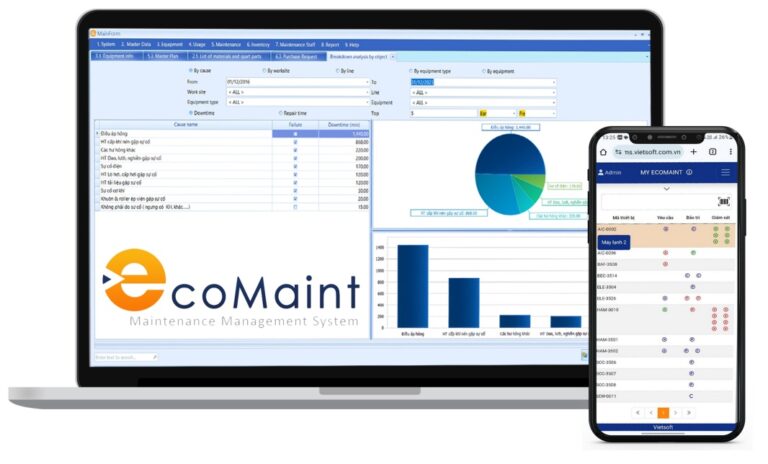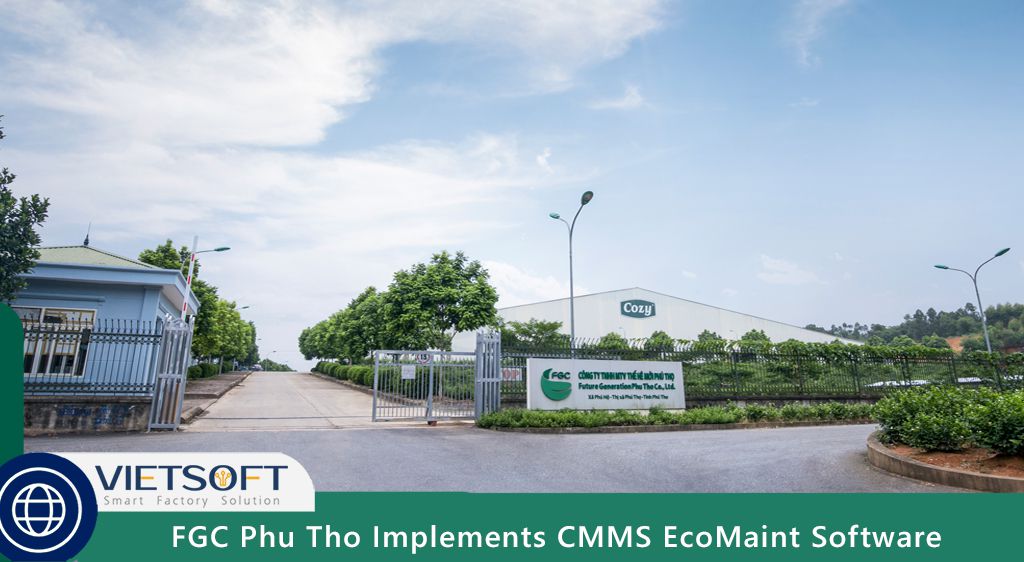
In the ever-evolving world of industrial maintenance, staying ahead requires leveraging cutting-edge tools that enhance efficiency, reduce downtime, and optimize resource use. One such transformative solution is Cloud-Based CMMS (Computerized Maintenance Management System) software. This innovative technology is redefining how maintenance teams manage assets, streamline operations, and adapt to modern challenges. Whether you’re a facility manager, a maintenance technician, or a business owner, understanding Cloud-Based CMMS can unlock new levels of productivity and reliability.
Let’s explore what it is, its pivotal role in maintenance management, and why it’s becoming an indispensable tool for industries globally.
I. What is Cloud-Based CMMS Software?
Cloud-Based CMMS is a sophisticated, web-based platform designed to centralize and streamline maintenance operations, asset tracking, and workflow management. Unlike traditional on-premise systems that depend on local servers and extensive hardware installations, Cloud-Based CMMS is hosted and managed by third-party providers on remote servers. This means that with a stable internet connection, maintenance professionals can access the system from virtually anywhere—be it the factory floor, a distant work site, or even from home during off-hours.
The system encompasses all aspects of maintenance management, including work order scheduling, preventive maintenance planning, inventory tracking, and performance analytics. The cloud infrastructure handles software deployment, updates, data security, and backups, relieving in-house IT teams of these responsibilities. For maintenance professionals, this translates to a user-friendly experience where the focus shifts from managing technology to executing maintenance tasks effectively. The scalability of Cloud-Based CMMS also allows it to grow with your business, accommodating new assets or additional users without the need for significant hardware investments.
II. The Role of Cloud-Based CMMS in Maintenance Management
In the realm of industrial maintenance, Cloud-Based CMMS acts as a game-changer by providing a unified platform that enhances visibility and control over assets and processes. It empowers technicians and managers to schedule preventive maintenance proactively, track the status of work orders in real-time, and analyze equipment performance data to predict potential failures. This predictive capability is particularly valuable in sectors like manufacturing, where unplanned downtime can lead to substantial financial losses and safety risks.
One of the standout features of Cloud-Based CMMS is its integration with the Industrial Internet of Things (IIoT). By connecting with sensors and smart devices, the system can monitor equipment conditions—such as vibration levels, temperature, or pressure—and trigger alerts when anomalies are detected. This condition-based monitoring allows teams to address issues before they escalate into costly breakdowns, thereby extending the lifespan of machinery and improving overall operational safety.
Moreover, Cloud-Based CMMS supports remote work, a critical advantage in today’s dynamic work environment shaped by global events and hybrid work models. Maintenance managers can oversee operations across multiple sites from a single dashboard, while technicians can update records or request parts on the go. This accessibility ensures that maintenance activities remain uninterrupted, even during unforeseen circumstances like natural disasters or supply chain disruptions.
III. Advantages of Cloud-Based CMMS Software
The adoption of Cloud-Based CMMS brings a host of benefits that address the diverse needs of maintenance teams. Below is an in-depth exploration of these advantages, tailored to the perspective of a seasoned maintenance professional.
1. Cost Efficiency and Flexible Pricing Models
Financial considerations are often at the forefront when selecting maintenance software, and Cloud-Based CMMS offers a compelling advantage here. Traditional on-premise systems require significant upfront costs for purchasing servers, licensing software, and hiring contractors for installation—often totaling tens of thousands of dollars. In contrast, Cloud-Based CMMS operates on a subscription-based model, typically charging a per-user, per-month fee that includes support, updates, and maintenance.
For example, a maintenance team of 15 technicians might pay $40 per user per month, amounting to $600 monthly or $7,200 annually. This is a fraction of the $25,000 upfront cost plus ongoing IT expenses associated with an on-premise system. The subscription model also eliminates hidden costs, such as those for hardware upgrades or emergency repairs, making budgeting more predictable. For small to medium-sized enterprises or startups, this affordability democratizes access to advanced maintenance tools, leveling the playing field with larger corporations.
2. Enhanced Accessibility and Mobility
One of the most transformative aspects of Cloud-Based CMMS is its accessibility. With an internet connection, users can log in from any device—desktops, laptops, tablets, or smartphones—making it ideal for a mobile workforce. Many providers offer dedicated mobile apps that allow technicians to perform critical tasks on-site, such as logging equipment issues, uploading photos of faults, or ordering spare parts, all without returning to a central office.
Consider a technician conducting an inspection at a remote wind farm. Using a Cloud-Based CMMS app, they can document a turbine blade issue, attach a video, and request a replacement part in real-time. This capability not only speeds up response times but also ensures that critical data is captured immediately, reducing the risk of errors or delays. For multi-site operations, this mobility fosters seamless coordination, enabling teams to maintain consistency across geographically dispersed locations.
3. Automatic Updates and Scalability
Keeping software current is vital for maintaining efficiency and security, and Cloud-Based CMMS simplifies this process with automatic updates. Vendors regularly release new features, performance enhancements, and security patches, which are applied seamlessly without requiring downtime or manual intervention. This ensures that maintenance teams always have access to the latest tools, such as advanced analytics or improved reporting modules.
Scalability is another key benefit. As a business expands—adding new machinery, opening additional facilities, or hiring more staff—Cloud-Based CMMS can scale accordingly. Adjusting the subscription to include more users or enhanced features is a straightforward process, often completed with a few clicks. This contrasts sharply with on-premise systems, where scaling requires purchasing new hardware, reconfiguring networks, and potentially disrupting operations. For a growing company, this flexibility ensures that the maintenance system evolves in tandem with business needs.
4. Improved Data Security and Reliability
Data security is a top priority for maintenance professionals handling sensitive information, such as equipment records or compliance data. Cloud-Based CMMS providers invest heavily in robust security measures, including data encryption, multi-factor authentication, and regular security audits. Data is stored across multiple redundant servers, often in different geographic locations, ensuring that it remains accessible even if one server fails.
For instance, during a power outage or natural disaster, Cloud-Based CMMS systems typically activate failover mechanisms to maintain service continuity. This reliability is critical in industries where downtime can lead to safety hazards, regulatory penalties, or lost production. Additionally, vendors handle backups automatically, protecting against data loss from hardware failures or human error—a task that falls to in-house IT teams in on-premise setups.
5. Seamless Integration and Collaboration
Cloud-Based CMMS excels in integrating with other business systems, such as Enterprise Resource Planning (ERP) software, inventory management tools, and IoT devices. This connectivity enables a holistic view of operations, allowing maintenance teams to align their schedules with production demands or procurement cycles. For example, a low stock alert from an inventory system can trigger a work order to replace a worn-out part before it fails.
Collaboration is also enhanced, as multiple users can access and update the system simultaneously. A supervisor can assign tasks, while technicians provide real-time progress updates, all within the same platform. This real-time interaction is particularly beneficial for multi-site organizations, where centralized data improves decision-making and ensures consistency. The open architecture of Cloud-Based CMMS facilitates these integrations with minimal effort, unlike the often complex custom coding required for on-premise systems.
IV. Disadvantages of Cloud-Based CMMS Software
While Cloud-Based CMMS offers numerous benefits, it’s important to acknowledge its limitations to ensure a well-rounded decision-making process.
1. Dependence on Internet Connectivity
The reliance on a stable internet connection is the most significant drawback of Cloud-Based CMMS. In regions with unreliable or slow internet, accessing the system or updating records can be challenging, potentially halting maintenance activities. For remote sites or industries operating in harsh environments—such as mining or offshore drilling—this dependency may require investing in satellite internet or developing offline functionality, adding to the overall cost.
2. Data Privacy and Compliance Concerns
Storing maintenance data on third-party servers raises privacy and compliance concerns, especially in regulated industries like pharmaceuticals, aerospace, or energy. Standards such as GDPR, HIPAA, or ISO 27001 may require specific data handling practices, necessitating thorough vetting of the provider’s security protocols. This could involve additional contracts or audits, increasing administrative overhead for maintenance teams.
3. Potential Vendor Lock-In
Switching Cloud-Based CMMS providers can be a complex process due to data migration challenges and compatibility issues. Extracting data, reformatting it for a new system, and retraining staff can take weeks or months, potentially locking organizations into long-term contracts with a single vendor. This lack of flexibility may deter businesses that value the ability to switch providers easily.
4. Customization Limitations
While Cloud-Based CMMS offers a robust set of standard features, it may not provide the deep customization possible with on-premise systems. Organizations with highly specialized workflows or legacy equipment might find that off-the-shelf solutions don’t fully meet their needs, requiring workarounds or custom integrations that can increase costs and complexity.
V. Cloud-Based CMMS vs. On-Premise CMMS: A Detailed Comparison
To determine the best fit for your maintenance needs, a comprehensive comparison of Cloud-Based CMMS and on-premise CMMS across various dimensions is essential. Here’s an expanded analysis:
1. Cost Comparison
- Upfront Costs: Cloud-Based CMMS requires minimal initial investment, typically limited to subscription setup fees (e.g., $500 for the first month). On-premise CMMS, however, demands significant upfront spending—$20,000 or more for servers, licenses, and installation.
- Recurring Costs: Cloud-Based CMMS includes ongoing subscription and support fees (e.g., $6,000 annually for 10 users), while on-premise systems have lower recurring costs but higher expenses for maintenance and upgrades.
- Additional Costs: On-premise CMMS requires ongoing investment in IT personnel, hardware maintenance, and training, whereas Cloud-Based CMMS keeps these costs low by outsourcing to the vendor.
2. Feature and Functionality
- Number of Features: Cloud-Based CMMS offers a dynamic feature set with frequent updates, such as AI-driven analytics, compared to the static offerings of on-premise systems.
- Customization: On-premise CMMS allows extensive initial tailoring to specific workflows, while Cloud-Based CMMS provides easier ongoing adjustments through configurable modules.
- Ease of Use: Cloud-Based CMMS features intuitive interfaces designed for diverse users, reducing the learning curve, whereas on-premise systems may require more technical expertise.
- Mobile Capabilities: Cloud-Based CMMS includes robust mobile apps with offline modes, while on-premise systems offer limited or no mobile support.
- Ease of Integration: Cloud-Based CMMS integrates seamlessly with modern systems via APIs, unlike the often rigid integration of on-premise setups.
3. Implementation and Support
- Ease of Implementation: Cloud-Based CMMS can be deployed in days with minimal setup, while on-premise systems may take weeks due to hardware configuration and testing.
- Training and Support: Cloud-Based CMMS provides comprehensive training and 24/7 support as part of the subscription, whereas on-premise systems rely on in-house resources or costly vendor contracts.
- Ease of Data Migration: Cloud-Based CMMS supports easy data imports from spreadsheets or legacy systems, a process that can be labor-intensive with on-premise solutions.
4. Security and Scaling
- Data Security: Cloud-Based CMMS benefits from vendor-managed security with regular audits, while on-premise systems require internal efforts that may lag in updates.
- Scalability: Cloud-Based CMMS scales with business growth via subscription adjustments, whereas on-premise systems need significant hardware upgrades.
VI. Practical Tips for Implementing Cloud-Based CMMS
Successfully implementing Cloud-Based CMMS requires careful planning. Here are detailed steps to ensure a smooth transition:
1. Assess Needs: Conduct a thorough audit of current maintenance processes to identify pain points, such as frequent downtime or manual reporting, and align them with system capabilities.
2. Evaluate Vendors: Compare providers based on feature sets, customer reviews, compliance certifications, and support availability. Request demos to test usability.
3. Plan Connectivity: Assess internet reliability at all sites and invest in backup solutions, such as satellite internet or offline modes, to mitigate disruptions.
4. Train Teams: Develop a training program tailored to different user roles (e.g., technicians, managers), incorporating hands-on sessions and ongoing support resources.
5. Monitor Performance: Establish KPIs, such as downtime reduction or work order completion rates, and use system analytics to refine processes continuously.
VII. Elevate Your Maintenance with CMMS EcoMaint by Vietsoft
With over two decades of experience in industrial maintenance and marketing CMMS solutions in Vietnam, I’ve witnessed the transformative impact of the right software. If the potential of Cloud-Based CMMS has piqued your interest, consider exploring CMMS EcoMaint by Vietsoft. This locally tailored solution harnesses cloud technology to deliver advanced asset management, real-time insights, and seamless integration—perfect for Vietnam’s diverse industrial landscape. Wondering how it can revolutionize your maintenance strategy? Discover the CMMS EcoMaint solution here.
Contact us for consultation via hotline: 0986778578 or email: sales@vietsoft.com.vn.




